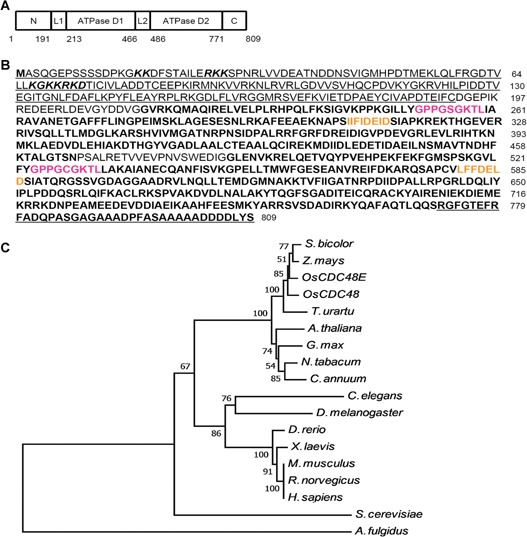Figure 10.

Predicted amino acid sequence of OsCDC48 and dendrogram of CDC48 proteins (A, B) The N‐terminus is underlined (1‐191 aa); two ATPase domains are in bold: D1 (213‐466 aa) and D2 (486‐770 aa); the C‐terminus is in bold and underlined (771‐809 aa); link 1 (DGEPIKREDEERLDEVGYDDVG) is located between the N‐terminus and D1; link 2 (PSALRETVVEVPNVSWEDIG) is located between D1 and D2; two nucleus signal peptides (KK (8×) RKK and KGKKRKD) are in italics in the N‐terminus; the Walker A are in magenta characters; the Walker B are in yellow characters. (C) A total of 18 CDC48 homologs from 17 different species were used for analysis including: OsCDC48 (LOC_Os03g05730), OsCDC48E (Os10g0442600), Arabidopsis thaliana (A. thaliana) (Q9LZF6), Nicotiana tabacum (N. tabacum) (XP_009628175), Glycine max (G. max) (P54774), Sorghum bicolor (S. bicolor) (XP_002465842), Zea mays (Z. mays) (XP_008671992), Triticum urartu (T. urartu) (EMS63012), Capsicum annuum (C. annuum) (Q96372), Archaeoglobus fulgidus (A. fulgidus) (O28972), Caenorhabditis elegans (C. elegans) (P54811), Saccharomyces cerevisiae (S. cerevisiae) (P25694), Danio rerio (D. rerio) (P23787), Drosophila melanogaster (D. melanogaster) (Q7KN62), Mus musculus (M. musculus) (Q01853), Rattus norvegicus (R. norvegicus) (P46462), and Homo sapiens (H. sapiens) (P55072). Distance scale = 0.05.
